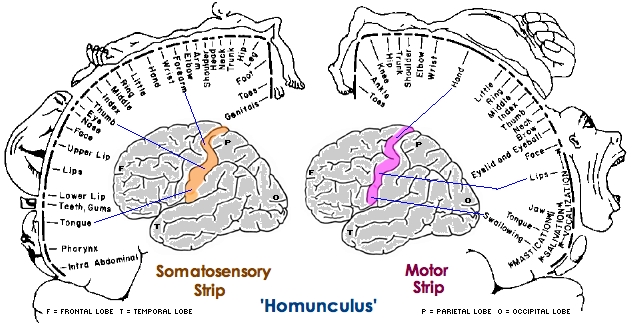| Two Hemispheres |
| Four major lobes |
| Cerebellum (Little Brain) coordination |
| Brain stem |
| Spinal cord |
Numbers
See Chudler[Chudler15:_brain_facts_figures] for more information
Note, Cerebellum innervates ipsilaterally whereas the cortex works contralaterally.
Penfield's Homunculus shows a strong mapping from brain regions to the body, however sensory motor actions utilise many other regions of the brain, for example the cerebellum is clearly involved although it is still not clear how.

| Area | function | |
| LGN | Lateral geniculate nucleus | Connects optic nerve to VA |
| IT | Inferior temporal cortex | Object recognition |
| IPL | Inferior parietal lobule | Interpretation of facial emotions |
| SPL | Superior parietal lobule | Orientation (connected to hand) |
| MSP | Medial superior temporal area | Optic flow ? |
| VA | Visual area | object colour, shape etc |
Retinal data, primarily from the fovea, travels down the optic nerve, through the optic chiasm to the Lateral geniculate nucleus. LGN transmits the information on to the primary visual area V1, and gets feedback from the visual cortex,
V2 and V2 seem to do an initial process of the visual data and then trasmit information on in two streams.

V1 V2 V4 V8 IT (this stream is heading towards the language areas of the brain)
V1 V2 V3 V7 (this stream is heading to sensory motor areas of the brain).
[Chudler15:_brain_facts_figures] Eric Chudler, Brain Facts and Figures last checked Nov 2015